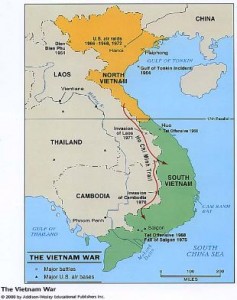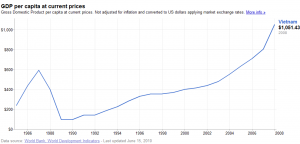History of Education
Educational Roots: Feudal Period(Up to the late 19th century):
As Vietnam’s educational culture was sparked by Chinese influence, the roots of education come from the country’s belief in Confucianism (Mongabay, 1987). Confucius taught that man is at the center of the universe, but that man cannot be alone; he finds happiness in community with others. He also taught the belief that everyone has the same potential to be educated, and therefore education should be available to everyone. Vietnam was therefore constructed to be a collectivist country, meaning that individuals are less important than the whole (Yee, 2002). Community is extremely important, so education is seen as a way to create a community of good citizens instead of a way for one to advance personally.
The Vietnamese believe that One of the traditional values of the Vietnamese people is the promotion of learning and the respect for teachers. In the Feudal and Colonial periods, teacher’s were seen to have more importance than parents; their position was “only lower than the king” (Worldbank, part 1.paragraph 1, 2010). The report by the WorldBank in 2010 explains that teachers would often be invited to live in the homes of wealthy villagers to teach the family’s children as well as other children in the village. To become a teacher, the mandarins requested that candidates have excellent learning achievements and have high marks in competitive exams. The first exam was conducted in 1075, and the first Confucian university was constructed in 1070, called the Temple of Literature. For about one thousand years, the Vietnamese people learned Chinese characters and used them to write but pronounced them in a Vietnamese way. This was done in order to preserve a certain national independence from the Chinese.
French Colonization(late 19th- mid-20th century):
As indicated in the 2010 WorldBank report, the French colonized Vietnam in the late 19th century. With this change in power, the Confucian-oreiented education that had been built and maintained by the Vietnamese was replaced with French-Vietnamese education, with the goal of training people to serve the colonial system. The French built elementary schools, primary schools, primary colleges, secondary schools, and three universities, all with French as the dominant language of instruction. However there were not very many schools built, so there was extremely limited access to
education during this period in Vietnam’s history. “With such an education system, 95% of Vietnamese people were illiterate” (WorldBank, part 1. paragraph 6, 2010). Growing frustration led to the country’s independence in the mid-20th century.
Independence to Reunification (1945-1975):
On September 2, 1945, Vietname gained independence from France. President Ho Chi Minh decided that the three key priorities of the new, independent government would be “fighting against poverty, illiteracy, and invaders” (WorldBank, part 1. paragraph 7, 2010). His new driving philosophy for education was “an illiterate nation is a powerless one” and, in October 1945, he issues a “Call for anti-illiteracy” (WorldBank, part 1. paragraph 8, 2010).
The president’s call was a success: within one year 75 thousand literacy classes were established with about 96 thousand teachers to help 2.5 million people learn to read and write.
During the years of resistance (1946-1954), schools operated in demilitarized areas. They stopped teaching in French and created curriculum in Vietnamese. The government passed an education reform in 1950 with the goal of reducing the years of general education and concentrating on reading, writing, and calculating skills.
Once peace was reached and Vietnam was completely independent from France (1954), the government began preparing for a new education reform in order to help rebuild the economy and to reunite the whole country (Kelly, 2000). The focus of the new reform was to train young people to become “future citizens, loyal to the people’s democracy regime, and competent to serve people and the resistance war ” (WorldBank, part 1. paragraph 10, 2010). The French 12-year-based curriculum and the first reform’s 9-year-based curriculum were combined to settle on a 10-year system. This new system was somewhat similar to that of USSR, following the influence of communism in Vietnam with the results from the Vietnam war. The US, who had been aiding South Vietnam, withdrew in 1973, and a cease-fire agreement was signed by both sides. In 1975, North Vietnam overran South Vietnam, Re-uniting the country under Communist rule.
After the War, Pre-reform (1975-1985)
In April 1975, when Vietnam was proclaimed as one, unified nation, the government took on two focuses in regards to education: (1) the removal of leftover influences from the old education system and (2) the implementation of anti-illiteracy activities for people in the age group of 12-50 years old.
The Ministry of Education decided to implement a 12-year system and they quickly printed and sent out 20 millions print materials to schools n South Vietnam. They also began to nationalize private schools and cut out religious influences in education.
Though the goal of these acts was to improve education, there were a number of challenges with the implementation of the government’s goals. The government wanted to universalize and nationalize curriculum to have all schools accept a centralized educational system. As the country was trying to unify in other areas as well, such as economically and socially, and was experiencing isolation from foreign resources, funding for the new initiatives was difficult (Mongabay, 1987). The country experienced very little economic and social growth for a little over a decade after the return of peace.
The Doi Moi Reform (1986)
After the unification of North and South Vietnam, the government took control over all aspects of the country, cutting out private companies and the free market. This created issues for businesses as well as for farmers. With the centralization of power, agriculture suffered, and the country was no longer producing enough rice to feed its population. The government decided to open up more room for diversity and allow a decentralization of the market in 1986 through the “Doi Moi” reform (Kelly, 2000).
“Doi Moi” mean “renovation” or “reconstruction” in Vietnamese (Mongabay, 1987). Its goal is to increase economic growth and development by liberating the economy within Vietnam and increasing Vietnam’s contribution to the global economic community. This includes decentralizing the economy and therefore removing the communist title of the country and replacing it with a more market-driven, socialist system (Mongabay, 1987).
As far as education is concerned, the Doi Moi reform means more funding for institutions and a higher percentage of government funds allocated to the education system (Kelly, 2000). It has also allowed for more privatization of institutions: “semi-public” and “people-funded” institutions are rising in popularity, and non-public education is especially popular at the pre-school level as well as the technical and vocational training level.
In 1998, Vietnam passed it’s first law on education, to solidify the objectives of the “Doi Moi” reform and provide a legal framework for the development of education(IRED, 2011). A few years later, the government realized that this law needed to be modified in order to increase accessibility of education. A new, amended education law was passed in 2005. This law cut out the use of “semi-public schools” and allows for public, people-funded, and private schools. It also made education universal for the primary education and lower secondary education, where the 1998 law only had universal primary education. Later, in 2012, upper secondary education was also made universal (IRED, 2011).
Information from:
“Education in Vietnam”.(2010). World Bank.http://siteresources.worldbank.org/EDUCATION/Resources/278200-1121703274255/1439264-1153425508901/Education_Vietnam_Development.pdf
Kelly, Kritsy.”The Higher Education System in Vietnam”. (2000). WENR. http://www.wes.org/ewenr/00may/feature.htm
“Overview on Vietnam’s Education System”. (2011). IRED. http://www.ired.edu.vn/en/EducationInVietNam/Read/overview-on-vietnam-s-education-system/
“Vietnam Index”.(1987). MongaBay. http://www.mongabay.com/history/vietnam/vietnam-education.html
WorldBank. “Education in Vietnam”.(2010). World Bank. http://siteresources.worldbank.org/EDUCATION/Resources/278200-1121703274255/1439264-1153425508901/Education_Vietnam_Development.pdf
Yee, Edmond. “Confucian Education: A Moral Approach”. (2002). Pacific Lutheran Theological Seminary. http://www.plts.edu/docs/confucian_education.pdf






